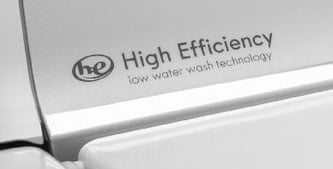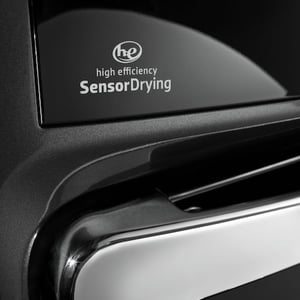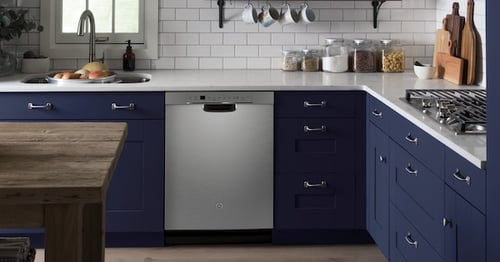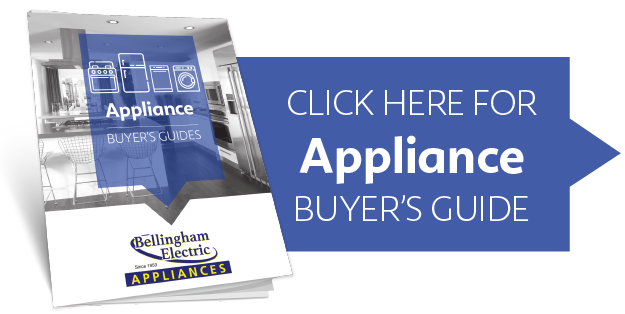
Even if an energy efficient model isn't at the top of your list of features when buying a new appliance, appliances that operate more efficiently can be a great deal for your wallet by reducing utility costs. We've all seen those blue Energy Star stickers on various appliances, from refrigerators to washing machines - but what do they actually mean? We'll explore the different meanings of Energy Star ratings on different appliances so you can see if the benefits are worth considering for your next appliance buying adventure.
Table of Contents
- What is Energy Star?
- What Does an Energy Star Rating Mean?
- Energy Star Washers & Dryers
- Energy Star Dishwashers
- Energy Star Refrigerators
- Energy Star Appliance Rebates
What is Energy Star?
The Energy Star rating system is set forth and maintained by the Environmental Protection Agency (EPA). An appliance can receive the Energy Star label by meeting certain efficiency guidelines through an independent certification process. These guidelines can be adjusted from year to year over time due to changes in technology, the actual household performance of rated products, and other factors. So as appliances as a whole get more efficient over time (e.g., most modern washing machines today use a lot less water compared to washers from ten years ago, even if they aren't Energy Star rated), the Energy Star rating system adjusts to account for that. To receive that little blue logo, an appliance has to undergo certain tests to make sure it lives up to the Energy Star standards.
What Does an Energy Star Rating Mean?
You can find an up-to-date list of the individual requirements for different appliances at the official Energy Star website. When it comes to appliances, here are the current requirements for Energy Star ratings, which are approximate rather than exact due to the variation between models:
-
Washing Machines: Use approximately 33% less water and 25% less energy for washing than standard models. They must also undergo a cleaning performance assessment and meet a certain average score based on a standardized test. (Don't be confused by a "High Efficiency" or "HE" symbol on the product packaging - this refers to the type of detergent you should use, and is not a good indicator of its performance efficiency.) Click here for a complete list of Energy Star washers.
-
Dryers: Use approximately 20% less energy than standard models. These models often incorporate sensor drying features to avoid expending unnecessary energy on "over-drying" clothes - which also helps reduce wear and tear on fabrics. Click here for a complete list of Energy Star dryers.
-
Dishwashers: Are on average about 12% more energy efficient and 30% more water efficient than standard models. They must also meet cleaning performance requirements on the Light, Medium/Normal, and Heavy cycles. Click here for a complete list of Energy Star dishwashers.
-
Refrigerators and Freezers: Are about 9% more energy efficient than standard models. Most use more efficient insulation and compressor mechanisms. Click here for a complete list of Energy Star refrigerators.
- Air Conditioners: Are 10% more energy efficient on average than standard models. Click here for a complete list of Energy Star window air conditioners.
(Source - A great handbook for consumers with a lot of information on how more efficient appliances save you money as well as how Energy Star calculates the cost savings!)

There are also Energy Star guidelines for dehumidifiers, air purifiers, and more. Today's Energy Star appliances save you hundreds of dollars in utility costs compared to appliances from the year 2000!
Then there's also the Energy Star Most Efficient distinction, which is awarded each year to products that offer cutting-edge efficiency and advanced features without compromising on function. The Most Efficient of Energy Star 2020 label means different things depending on the product:
-
Washers: Energy savings are 24% over the federal minimum and water savings are 37% over the federal minimum.
-
Dryers: Energy savings are 28% on standard electric models, 25% on gas models, and 43% on compact ventless models compared to the federal standard.
-
Dishwashers: Energy savings are 22% over the federal minimum and water savings are 36% over the minimum.
-
Refrigerators and Freezers: Energy savings are 10-20% over the federal minimum.
Energy Star Washing Machines & Dryers
How does the EPA measure washing machine efficiency? They use two measures: the Integrated Modified Energy Factor (IMEF) and Integrated Water Factor (IWF).
-
IMEF: Considers the energy used to run the washer, heat the water, run the dryer, and the combined low power mode energy consumption. A higher IMEF means more efficiency!
-
IWF: Calculates gallons of water used per cubic foot of capacity across all wash cycles. A lower IWF means more efficiency!
So a clothes washer meeting Energy Star requirements will have a high IMEF and a low IWF. Since Energy Star has been around for a while, they have some great data on running costs, too. The annual running costs have decreased a lot over the years:
-
A 1990 washer cost $318/year to run
-
A 2000 washer cost $280/year to run
-
A 2018 Energy Star washer costs $85/year to run
In addition, all clothes washers undergo a standardized cleaning performance test, which follows standards set by AHAM (the Association of Home Appliance Manufacturers, a trade group). The EPA wants to consider performance as well as energy efficiency! Manufacturers uses these tests when designing new models. Review organizations typically riff off of AHAM's standards in some way - for example, click here to read about how CNET tests washer cleaning performance and how it compares to AHAM's standards.
In 2018, 50% of washing machines sold were Energy Star rated, down from about 64% in 2010.
What about the HE symbol? You'll see this symbol on washers and dryers. When it's on a washing machine, that means it's designed to be used with HE detergents. These low-sudsing detergents are optimized for cool water, so you can get a great wash with less water and at a lower temperature.

When it's on a dryer, that usually means the dryer features sensor dry technology, with a moisture sensor in the drum monitoring your clothes so the dryer only runs until your clothes are dry. It's much more accurate than timed drying, saving you energy and wear and tear on your fabrics! While it's a great feature to look for, and an Energy Star dryer is required to have sensor drying, not all sensor dry machines are Energy Star rated.

What about dryers? Energy Star ratings for dryers are relatively recent (2015), in part because creating heat from gas or electricity is a relatively "efficient" process - an electric space heater can claim close to "100% efficiency" at converting electricity into heat, but it still costs money to run! The dryer is typically the second-biggest energy user in a home. First place: the refrigerator. Considering that a refrigerator runs 24-7 while a dryer may only be used for a few hours each week, that's an impressive chunk of the pie! So improving dryer efficiency focuses on factors like...
-
A low heat setting: Although this extends drying times, it actually uses less energy than a shorter high heat setting. Plus, it's not as damaging to delicate fabrics! (That being said, these dryers still offer quick drying settings for when you need them.)
-
Sensor drying: Again, sensor drying isn't the same as being Energy Star rated, but this feature is a requirement for a dryer to earn the Energy Star.
The metric used to measure a dryer's efficiency is the Combined Energy Factor (CEF). This number is achieved by dividing the dryer test load weight by the sum of the consumption when in standby/not in use and the total energy consumption per cycle.
Energy Star Dishwashers
Dishwashers are tested for their cleaning performance using standards set by AHAM (the Association of Home Appliance Manufacturers, a trade group) as well as for water usage and electricity usage. This includes electricity usage while in standby. The Energy Guide annual cost is based on an average of 215 cycles per year.
Over time, we've seen some great decreases in the annual running costs of dishwashers:
-
A 1990 dishwasher cost $87/year to run and used 14 gallons of water per wash
-
A 2000 dishwasher cost $64/year to run and used 10 gallons of water per wash
-
A 2018 Energy Star dishwasher costs $35/year to run and uses 3.5 gallons of water per wash
In part due to changing energy requirements, we're seeing more dishwashers using different drying methods rather than the electric-powered heat dry of the past. For example, Bosch released a new Crystal Dry technology in 2019 that uses minerals that release heat when exposed to moisture - a design that doesn't increase energy consumption! Some dishwashers also pop open automatically at the end of a cycle to vent moisture away from your dishes.
Some cool technological advances in Energy Star rated dishwashers include:
-
Improved high-pressure jets so you don't have to pre-rinse your dishes
-
Internal water heaters that reduce water heating costs (and having water at the right temperature ensures that your dishwasher gives its best clean)
-
Soil sensors help the dishwasher make adjustments throughout the cycle to ensure that your dishes come out sparkling clean
In 2018, about 90% of dishwashers sold were Energy Star rated!

Energy Star Refrigerators
Energy Star refrigerators are at least 9% more energy efficient than the minimum federal government standard. Technologies like improved compressors (which are usually quieter, too!), better insulation, and more precise temperature and defrost mechanisms help these models save energy.
How much is your old refrigerator costing you? Here are some averages from over the years:
-
A 1990 refrigerator cost $164/year to run
-
A 2000 refrigerator cost $113/year to run
-
A 2018 Energy Star refrigerator costs $60/year to run
Some households move the old refrigerator to the basement or garage and use it for additional storage after they buy a new fridge - but, as you can see, you could run two 2018 Energy Star refrigerators for about the same cost as a single 2000 refrigerator. See if your appliance retailer will recycle your old model! If you want extra storage space, consider buying a new top freezer refrigerator or a chest freezer, which will be much more efficient than a 10+ year old model and can be pretty inexpensive upfront.
Top freezers are the most efficient - Energy Star top freezer models use less energy than a 60-watt light bulb and are 10-30% more efficient than side by side and bottom freezer refrigerators (depending on size and features like in-door ice). Here are the average costs broken down by refrigerator style, assuming you buy an Energy Star rated model:
-
Top freezer: $45/year (360 kWh)
-
Bottom freezer (including French door refrigerators): $70/year (560 kWh)
-
Side by Side: $75/year (630 kWh)
The most energy efficient models are typically 16-20 cubic feet, but you should purchase a refrigerator that matches your household size - read more in our refrigerator buying guide. In 2018, about 46% of refrigerators sold were Energy Star rated.

Energy Star Appliance Rebates
Looking to save even more money on Energy Star Appliances? Enter your zip code into the Energy Star Rebate Finder to take advantage of special offers in your state, county, and local area. Rebates are often offered through energy providers rather than through appliance dealers, and may be for the purchase of an Energy Star product or for recycling an older inefficient product. For the best price, you can "stack" these Energy Star-specific rebates with other appliance rebates and holiday sales!
You can also use the Energy Star Best Value Finder to help narrow down the best Energy Star appliances for your needs.
What do you think about Energy Star appliances? Although some of us may miss the performance and simplicity of older appliances, the cost savings of new efficient appliances are pretty significant. Leave us a comment below - We'd love to hear from you!
Editor's Note: This blog was originally written in July of 2018 and has been completely revamped and updated for accuracy as of the publication date noted above.
Note: Source for 2018 Energy Star market penetration (percent of units sold that were Energy Star rated) can be found here.



